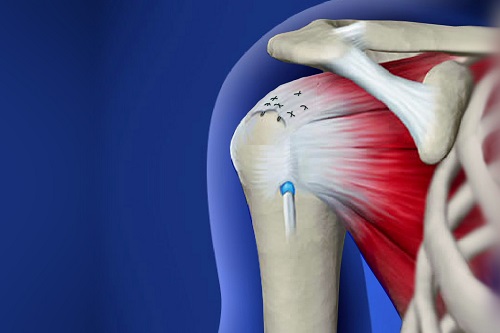Rotator Cuff Repair

If nonsurgical treatments fail to alleviate the pain from a torn rotator cuff, your doctor might recommend surgery as the next step. The primary reason for considering surgery is persistent pain. Additionally, for individuals who are highly active or engage in overhead activities and sports, surgery might be proposed to ensure optimal arm function.
Considerations for surgery may include the following criteria:
- Your symptoms have persisted for 6 to 12 months.
- The tear is large (over 3 cm) with the surrounding tendon tissue still in good condition.
- There is notable weakness and a decrease in the function of your shoulder.
- The tear resulted from a recent injury that occurred suddenly.
Surgical Repair Options
Several surgical options are available for the repair of rotator cuff tears, with modern advancements focusing on less invasive techniques. Despite the differences in these methods, their primary objective remains consistent: to reattach the tendon to the bone effectively.
The choice of surgical technique is influenced by various factors, such as:
- The surgeon’s expertise and preference for certain procedures
- The extent of the tear
- The patient’s anatomical considerations
- The condition of the tendon tissue and bone
Most of these surgical repairs are outpatient procedures, eliminating the need for an overnight hospital stay. Your orthopedic surgeon will work with you to select the most suitable approach based on your specific health requirements.
In addition to rotator cuff tears, patients might also be dealing with other shoulder issues, including:
- Biceps tendon injuries
- Osteoarthritis
- Bone spurs
- Tears in other soft tissues
It’s often possible for these additional concerns to be addressed during the same surgical session.
The three primary techniques commonly employed for rotator cuff repair are:
- Traditional open repair
- Arthroscopic repair
- Mini-open repair
Ultimately, patients report comparable outcomes in terms of pain relief, strength restoration, and overall satisfaction across all three types of repair techniques.
What is meniscus surgery recovery like?
Recovery following meniscus surgery varies based on the specific procedure undertaken. Healing typically takes longer for a meniscus repair compared to a meniscectomy. Full recovery may span from six weeks to three months, depending on individual circumstances. Post-surgery care commonly includes:
- Utilization of crutches to alleviate stress on the knee during the healing process.
- Wearing a knee brace to provide stability to the joint as it heals.
- Administration of pain medications as needed.
- Engagement in physical therapy sessions.
- Incorporation of rehabilitation exercises at home aimed at restoring mobility, range of motion, and strength.
- Application of the RICE protocol (rest, ice, compression, and elevation) to manage swelling and discomfort.
